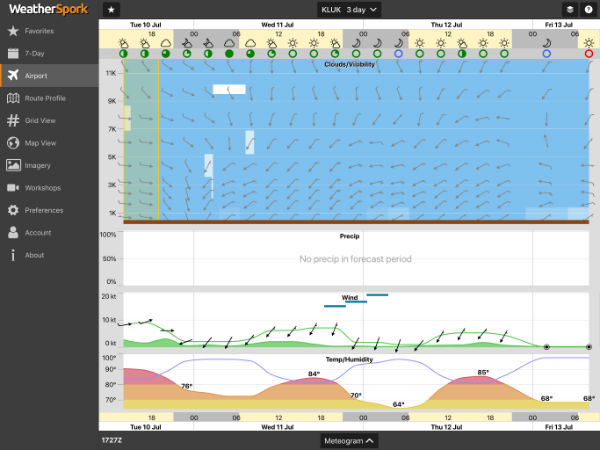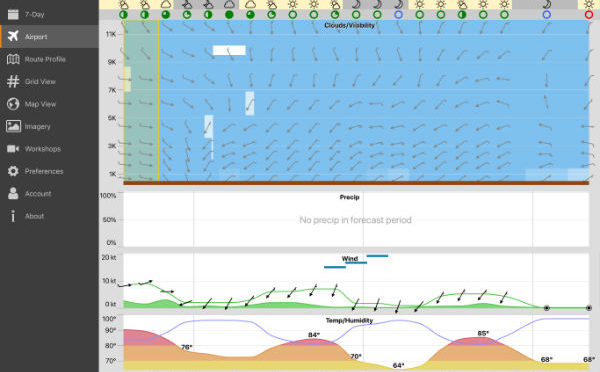
Weather is a constant struggle for pilots, no matter how many hours are in your logbook. While the big electronic flight bag (EFB) apps like ForeFlight and Garmin Pilot are loaded with weather tools, a new app is taking a different approach to help pilots make smarter preflight decisions.
WeatherSpork is not an EFB app, but rather an easy-to-use app that focuses on smarter preflight weather briefings. The company was co-founded by Scott Dennstaedt, a well-known former meteorologist and active flight instructor who worked at ForeFlight until last year. Dennstaedt’s goal is to improve pilots’ understanding of weather, and in particular to help them choose the best day and time for departure. Here’s a hands-on review.
7-Day
The first option (after Favorites, which allows you to pick commonly-used weather reports) is the 7-day forecast. This is a good place to get the big picture view of your departure or destination airport. Tap on the airport identifier at the top to change the forecast location.
Airport
Next up is Airport, which provides a number of advanced weather observations and forecasts for specific locations. Tap the menu at the top to choose a location, then tap the menu at the bottom to choose which type of weather product you want to see. There are 11 options overall, including METAR, Radar and Forecast Discussion. Two unique options we really like are the Meteogram and the Skew-t diagram. The Meteogram gives you a great 3D view of the atmosphere at the selected airport, including visibility, ceiling, precipitation, and winds. Tap and drag your finger from left to right to view details at different points throughout the 3-day forecast period.
The Skew-T log (p) diagram shows a somewhat complicated chart, based on the RAP model forecasts. Once you learn how to interpret the chart, there is a lot of information packed into one screen. These charts aren’t always easy to access, so it’s nice to see them here in an aviation app.
Route Profile
After reviewing your departure and destination airports, step down to the Route Profile page. This allows you to enter a departure airport, a destination airport, and up to two intermediate airports. Then you’ll see a 3D representation of wind, clouds, AIRMETs, and even terrain – ideal for choosing the best cruising altitude.
Grid View
The Grid view option looks a little intimidating at first, but we found it to be a helpful visual representation of various weather forecast products. Again, enter your route at the top. Then you’ll see familiar VFR/MVFR/IFR/LIFR colors along your route of flight. You’ll also see your flight as it progresses, so you can view the forecast weather as you pass each reporting point. Tap on a color-coded square for the detailed forecast.
Map View
This may be the most familiar view for pilots, and it shows what you would expect: METAR symbols, SIGMETS, and AIRMETs. Tap on a symbol for more than just the standard METAR info; you’ll also find crosswind component, and the forecast for storms in the next six hours. Some of this data is based on Model Output Statistics (MOS) forecasts. Notably, there is no option to display aviation charts or radar, two features we’d like to see added at some point in the future.
One interesting feature is what WeatherSpork calls the Wheels Up Departure Advisor. Instead of focusing on a single departure time, the app tries to determine when the best weather will be. Tap the ETD menu button at the bottom to display a color-coded timeline.
Imagery
The Imagery page will look familiar to users of EFB apps, but there are a lot of advanced weather products here beyond prog charts and radar. There are multiple options for viewing forecast models, including the HREF, GFS, and NAM. These are highly technical forecasts, but when presented in graphical form they offer a great way of evaluating weather beyond a typical 12-hour TAF window. There are also a number of icing forecast products available.
Workshops
One bonus feature is a series of 80 recorded presentations by Dennstaedt. These are typically narrated slideshow presentations on specific topics like shallow convective icing, Skew-t diagram interpretation, convective outflow boundaries, and ASOS sensors. Most are about 10 minutes in length, and all are included with your WeatherSpork subscription. Some of these are pretty geeky, but if you’re looking to take your weather skills to the next level, they are definitely worth some time.
Online
There’s also an online version of WeatherSpork, which is helpful for preflight planning on a big screen. Routes and airports are synced, so you can start planning a trip online and pick up right where you left off in the app. Functionality is identical to the app.
Conclusion
WeatherSpork was a pleasant surprise for us. While it’s definitely not an EFB app (no charts or flight plan filing, for example), it accomplishes what it sets out to do. It’s very simple to use, with a basic but effective layout, and a help button on every page. For planning a flight a few days in the future – especially for VFR pilots – we think it can save time and help you make better decisions. It’s also fun to play around with if you’re a weather geek.
The app is free to download and from there you can sign up for a free 7-day trial to test everything out. An annual subscription is $79/year, and includes full access to the 80 educational workshops from AvWxWorkshops.
The post WeatherSpork offers new approach to aviation weather appeared first on iPad Pilot News.
Source: Ipad appsWeatherSpork offers new approach to aviation weather









